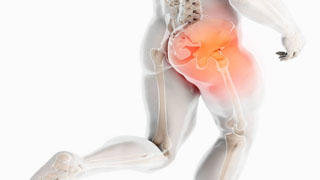
Why should you strengthen your gluteal muscles
-The gluteus maximus is one of the largest muscles in the human body and an important stabilizing and exercising muscle. However, most people have weak gluteus muscles due to factors such as a sedentary lifestyle, neglect of strength training, and fear, which can lead to "dead buttocks syndrome" or "gluteus muscle amnesia".
2. Hip joint stability and hip joint range of motion
-The hip joint is a ball and socket joint surrounded by stabilizing muscles. Excessive range of motion can lead to hip imbalance, and a stable hip relies on a balanced muscle stabilizer. The gluteal muscles become weak due to improper and insufficient use, while the hip flexors become tense and overactive due to misuse and overuse. Sitting for a long time can lead to tight hip flexors and weak gluteal muscles. Stretching the gluteal muscles when experiencing buttock pain may result in weaker and more pain. Yoga practitioners have also realized the importance of stabilizing the buttocks by enhancing strength.
3. How to effectively stabilize the buttocks
-If the buttocks are tight, it is recommended to relax the flexor muscles of the hips first, and release the quadriceps femoris and tensor lata fascia with the foam axis to eliminate the feeling of tightness and help activate and adjust the range of motion of the gluteus muscles.
4. 9 hip strengthening exercises for hip pain
-Prone hip extension: prone, chin or forehead on hand, legs together, activate core and gluteus maximus muscles, lift off cushion with one leg, top press buttocks and slowly lower, do 10-12 times before changing sides.
-Backward lunge: Backward lunge can exercise the stability of the gluteal muscles and core, keep the buttocks and core tense, keep the knees above the feet, keep the back straight, repeat on the same side or alternate on both sides. Beginners can perform static backward lunges.
-Backward sliding lunge: It is a low impact exercise that challenges the core muscle group. Be careful not to bow your back and use a slider.
-Hip joint hinge to leg lift: Wrap the strap around the hips, push the hips backwards instead of downwards when using hip joint hinge, keep the back stable and straight when pushing, and use elastic bands to ensure hip muscle activity.
-Standing hip extension: Fix the open or closed loop strap on a heavy object, tie the other end to the foot, tighten the gluteal muscles, extend the hips backwards, repeat 9-10 times and switch sides.
-Hip bridge: When doing bridge exercises, use elastic bands to tighten the core and gluteal muscles, push the heel of the foot to lift the buttocks, keep breathing, squeeze the buttocks at the top, and slowly lower them.
-Hip flexor activation bridge: Fix the strap on the calf and foot, mobilize the core and gluteus maximus muscles, lift the buttocks while bending them and pulling the strap, maintain core activity, slowly lower and repeat.
-Single leg hip bridge: Similar to a regular hip bridge, lift the leg without bending too much, tighten the core and buttocks when pushing the heel of the foot. If it is difficult, you can first practice a regular bridge.
-Hip Bridge to Puller: It is an intermediate hip stabilization exercise. Starting from the bridge exercise, lift the buttocks and hold them, and pull the strap when moving the knee outward to activate the gluteus maximus and gluteus medius muscles.
-Elastic band side leg lift: can be completed with only body weight, adding elastic band can control leg height, ensure buttocks do not rotate or bend, use walls to maintain alignment, and keep gluteal muscles and core tight to complete the entire set of movements.
-Flip up style: Align your back against the wall, bring your feet together and wrap a strap around your thighs. Lift your upper knee away from your lower knee and hold the top for 1-2 seconds before slowly lowering it. Repeat 8-10 times on each side to strengthen your gluteus medius and buttocks, and maintain a neutral posture.
-Contraction of gluteus maximus: With all four limbs on the ground, wrap straps around the thighs, keep the back neutral and the core engaged, bend the legs, kick towards the ceiling with force from the buttocks, control the movement, with the top thigh parallel to the floor and the foot pointing towards the ceiling.
-Adductor squeeze bridge: put a foam shaft or pad between the thighs, mobilize the gluteus and the core to do bridge exercises, and squeeze the roller/pad with the thighs at the same time, tighten the adductor for 10 seconds, then slowly put it down, repeat 4 groups.
I hope these exercises are helpful to you. If you often experience hip pain, you can refer to relevant plans to address the triggering factors of pain and avoid getting injured again.


